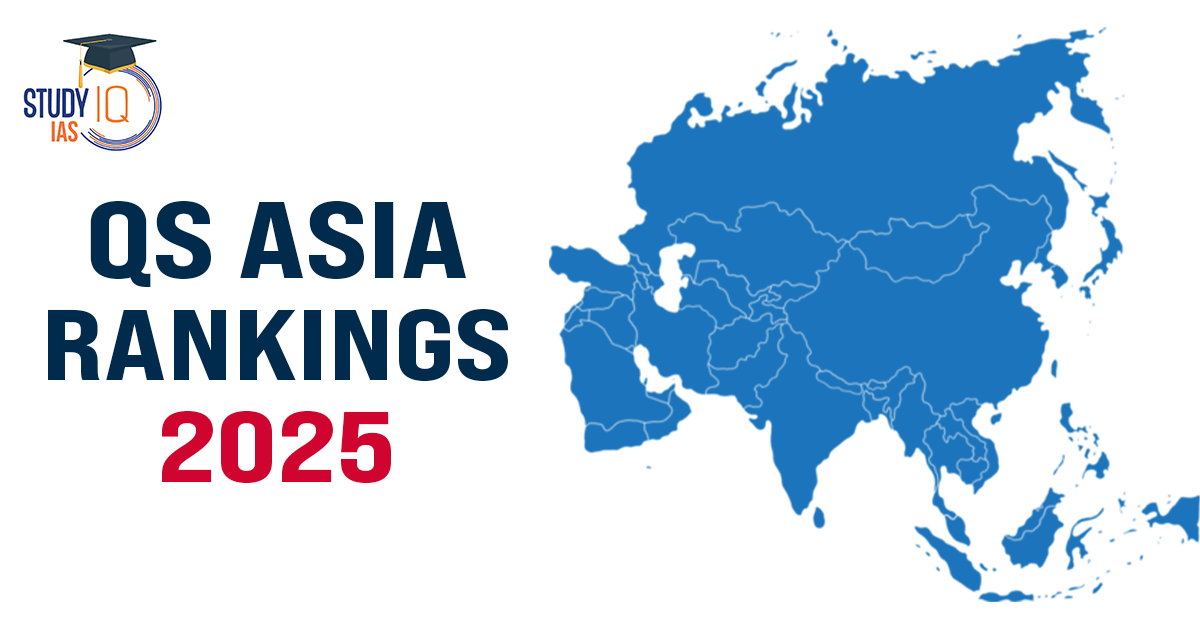Table of Contents
The QS Asia University Rankings 2025 reveal a shifting landscape in Asian higher education, with noteworthy performances from Indian institutions. Released by Quacquarelli Symonds (QS), these rankings evaluate universities across multiple parameters such as academic reputation, employer reputation, and research output. For UPSC aspirants, understanding these rankings can be helpful in analyzing India’s global standing in education, an area often highlighted in the General Studies (GS) papers, as well as topics related to international relations, economic development, and education policy.
QS Asia University Rankings 2025
The QS Asia University Rankings focus on evaluating universities in Asia using 11 key performance indicators:
- Academic Reputation
- Employer Reputation
- Faculty-Student Ratio
- Citations per Paper
- Papers per Faculty
- International Faculty Ratio
- International Student Ratio
- Staff with PhDs
- International Research Network
- Outbound Exchange Programs
- Inbound Exchange Programs
These parameters collectively provide a comprehensive look at each institution’s performance, including research output, teaching quality, and global reach.
Top 10 Asian Universities in QS Asia Rankings 2025
| Rank | University | Location | Score |
|---|---|---|---|
| 1 | Peking University | Beijing, China | 100 |
| 2 | University of Hong Kong | Hong Kong | 99.7 |
| 3 | National University of Singapore (NUS) | Singapore | 98.9 |
| 4 | Nanyang Technological University (NTU) | Singapore | 98.3 |
| 5 | Fudan University | Shanghai, China | 97.2 |
| 6 | Chinese University of Hong Kong (CUHK) | Hong Kong | 96.7 |
| 7 | Tsinghua University | Beijing, China | 96.3 |
| 8 | Zhejiang University | Hangzhou, China | 96 |
| 9 | Yonsei University | Seoul, South Korea | 95.4 |
| 10 | City University of Hong Kong (CityUHK) | Hong Kong | 95.3 |
India’s Position in QS Asia Rankings 2025
India made a significant mark in this year’s QS rankings:
- Most Represented Country: With 162 universities listed, India surpassed China (132 institutions), making it the most represented country in Asia.
- Top Indian Institutions: IIT Delhi ranked the highest among Indian institutions, at 44th place. Following IIT Delhi are IIT Bombay at 48th and IIT Madras at 56th. Six Indian universities are in the top 100 in Asia.
Top Indian Institutions in QS Asia University Rankings 2025
| Rank | Institution | Location |
|---|---|---|
| 44 | Indian Institute of Technology Delhi (IITD) | New Delhi |
| 48 | Indian Institute of Technology Bombay (IITB) | Mumbai |
| 56 | Indian Institute of Technology Madras (IITM) | Chennai |
| 60 | Indian Institute of Technology Kharagpur (IIT-KGP) | Kharagpur |
| 62 | Indian Institute of Science (IISc) | Bengaluru |
| 67 | Indian Institute of Technology Kanpur (IITK) | Kanpur |
In 2025, IIT Delhi leads Indian institutions at 44th position, followed by IIT Bombay and IIT Madras. A total of six Indian institutions have made it to the top 100 in Asia, showcasing India’s growing prominence in higher education across the region.
Analysis: The Growing Influence of Indian Universities
India’s impressive representation in the QS rankings is attributed to major strides in academic excellence, research funding, and global collaborations. Over recent years, the Indian government has invested in:
- Research and Development: Enhanced funding has been allocated to promote research output and innovation.
- International Collaboration: Many Indian universities are collaborating with global institutions to enhance academic and research opportunities.
- Reforms in Higher Education: Recent initiatives, such as the National Education Policy (NEP) 2020, have laid the groundwork for expanding India’s educational framework, focusing on critical thinking, research, and innovation.
In 2025, 21 new Indian institutions were added to the QS Asia Rankings, reflecting the growing emphasis on improving academic standards and global presence.
Challenges for Indian Universities in Competing Globally
Despite the strong representation, only two Indian institutions are in the top 50, indicating the challenges Indian universities face in achieving higher global ranks:
- Funding and Resources: Many Indian universities have limited funding compared to top institutions in other countries, impacting research capabilities and faculty recruitment.
- Global Engagement: Indian universities often lag in international faculty and student ratios, affecting their global outreach and reputation.
- Innovation and Research Output: There is a need for increased emphasis on research output and faculty-student engagement to compete with leading universities in Asia.
- Faculty-Student Ratio: Many Indian institutions struggle to maintain an optimal faculty-student ratio, which affects student support and learning quality.
Government Initiatives and Future Prospects
To overcome these challenges, the Indian government is focusing on several initiatives:
- Institution of Eminence (IoE): This initiative grants autonomy and funding to select institutions to promote excellence and global competitiveness.
- NEP 2020: With its focus on holistic and multidisciplinary education, NEP 2020 encourages research, innovation, and global partnerships to strengthen India’s education system.
- Collaboration and Exchange Programs: Government-backed initiatives for global collaboration aim to increase the presence of international faculty and students in Indian universities.
India’s growing representation in the QS Asia University Rankings highlights its progress but also underscores the need for continuous reforms and investment to elevate more institutions into Asia’s top echelons.
Conclusion
The QS Asia University Rankings 2025 mark a milestone for Indian higher education, with India becoming the most represented country in Asia. This achievement underscores the impact of recent educational reforms, increased funding, and government initiatives aimed at strengthening India’s global presence. For UPSC aspirants, understanding these rankings offers valuable insights into India’s education system, its strengths, and the challenges ahead. As India continues to implement policies to bolster its educational framework, the QS rankings reflect a positive trajectory, one that could eventually place more Indian universities among the very top in Asia.


 New Phase of Operation Chakra to Combat ...
New Phase of Operation Chakra to Combat ...
 Soyuz Aircraft: History, Design and Sign...
Soyuz Aircraft: History, Design and Sign...
 Topological Materials: The Future of Qua...
Topological Materials: The Future of Qua...





















